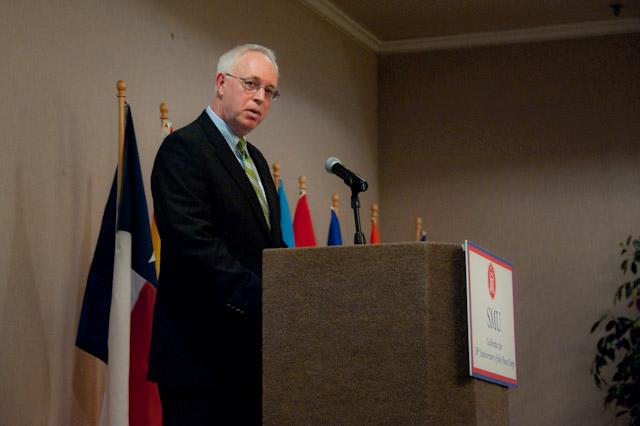
Peace Corps Southwest Regional Manager and SMU graduate Mike McKay speaks over the past, present and future of the Peace Corps at the 50th Anniverary celebration luncheon in the Hughes-Trigg ballroom Tuesday. (Sidney Hollingsworth/The Daily Campus)
In 1960, then-Sen. John F. Kennedy challenged students at the University of Michigan to serve their nation in the name of peace by working and living in developing countries.
His goal became a reality in 1961 when he became president and established the Peace Corps.
Faculty, students, alumni and returned Peace Corps volunteers alike filed into the Hughes-Trigg Student Center Ballroom Tuesday afternoon for a celebratory luncheon to commemorate the 50th anniversary of the Peace Corps.
Peace Corps is an independent U.S. government agency that provides trained volunteers to countries requesting assistance.
Today, the Peace Corps serves to promote peace and friendship by helping interested countries meet their need for volunteers and by encouraging both a better understanding of the American people and the people served by America.
Ceci Hutchings, an SMU senior, attended Tuesday’s luncheon and said she’s considering joining the Peace Corps after she graduates.
According to the Peace Corps website, “For Americans interested in service, Peace Corps is a life-defining leadership opportunity.”
Since its inception, over 200,000 Americans have served in the Peace Corps, spanning 239 countries around the globe. Today, Texas ranks third with the highest number of Peace Corps volunteers.
In the past, 111 SMU alumni have served in the Peace Corps and currently eight SMU alumni Peace Corps volunteers are working around the world.
Paul Ludden, SMU provost and vice president for academic affairs who spoke at the luncheon, said, “[Peace Corps] not only builds bridges between people but among countries.”
Thomas Tunks, professor of music at SMU, began recalling his experience while working as a Peace Corps volunteer in Colombia, South America in the late ‘60s by forming a V sign (peace sign) with his left hand to engage the audience’s attention. Before joining the Peace Corps in 1968, Tunks said he was an isolated individual.
Unlike many of his peers he adamantly opposed the Vietnam War.
He didn’t want to go to Canada and hideout. Instead, he said he wanted to do something he thought was worthwhile for his country. He heard about the opportunities Peace Corps offers.
“I thought, you know, this sounds like a real possibility. I can do something worthwhile and learn something [too]. So I joined, and it turned my life around completely,” he said.
As a senior at Yale University, Dennis Cordell, a history professor at SMU, decided to join the Peace Corps — the same year as Tunks. Cordell served in Chad, Africa until 1970.
He said he thought the opportunity sounded like something new and spectacular. “If you’re thinking about what to do next, I urge you to consider the possibilities of the Peace Corps. You very well may end up with the hardest job you ever loved.”
Susan Kress, director of SMU Engaged Learning, had the opportunity to attend graduate school at Chicago Art Institute but decided she didn’t want to stay in the Midwest.
“I applied on a whim,” she said. Her application was approved and she found herself working in Malaysia, Southeast Asia, where she engaged in community building. At the luncheon, she wanted to thank the Peace Corps for giving her the opportunity to be “a citizen of the world.”
Allison Hannel, senior brand marketing manager at AT&T and SMU ’04 alumna joined the Peace Corps in 2005 and worked in Honduras, Central America in the town of San Juancitountil 2007.
There, she opened San Juancito’s first restaurant in an old school bus in the middle of town; it was even open on weekends, serving eight combinations of rice, beans and tortillas.
“The measure of success for me was that two to three months after our restaurant opened, more opened,” she said.
Mike McKay, Peace Corps Southwest regional manager and SMU alumnus, said, “We’re one of the few organizations that can say the experience changes lives. It’s changed the lives of the countless people served, and if you let it, it will change yours.”
Today, more than 50 years after Kennedy’s initial call to service, the Peace Corps is more important and relevant than ever. Issues like poverty, disease, HIV/AIDS, illiteracy and hunger are all now combated by Peace Corps volunteers.
According to McKay, what began on a college campus in 1960 has changed the way America sees the world and how the world sees the United States.











